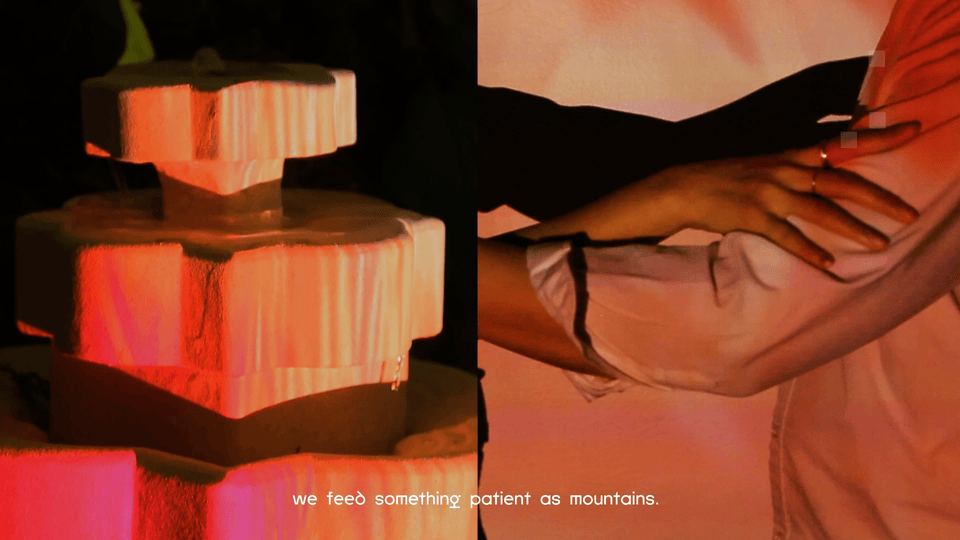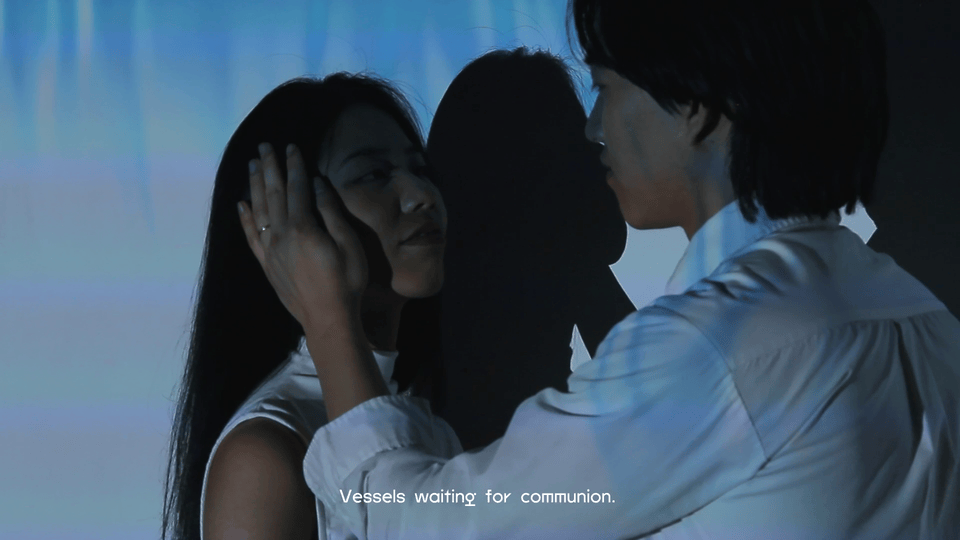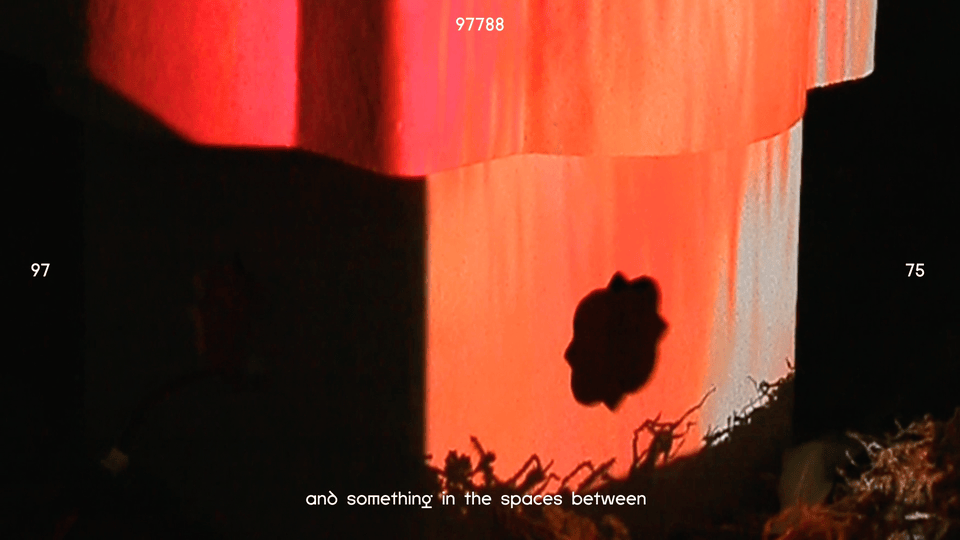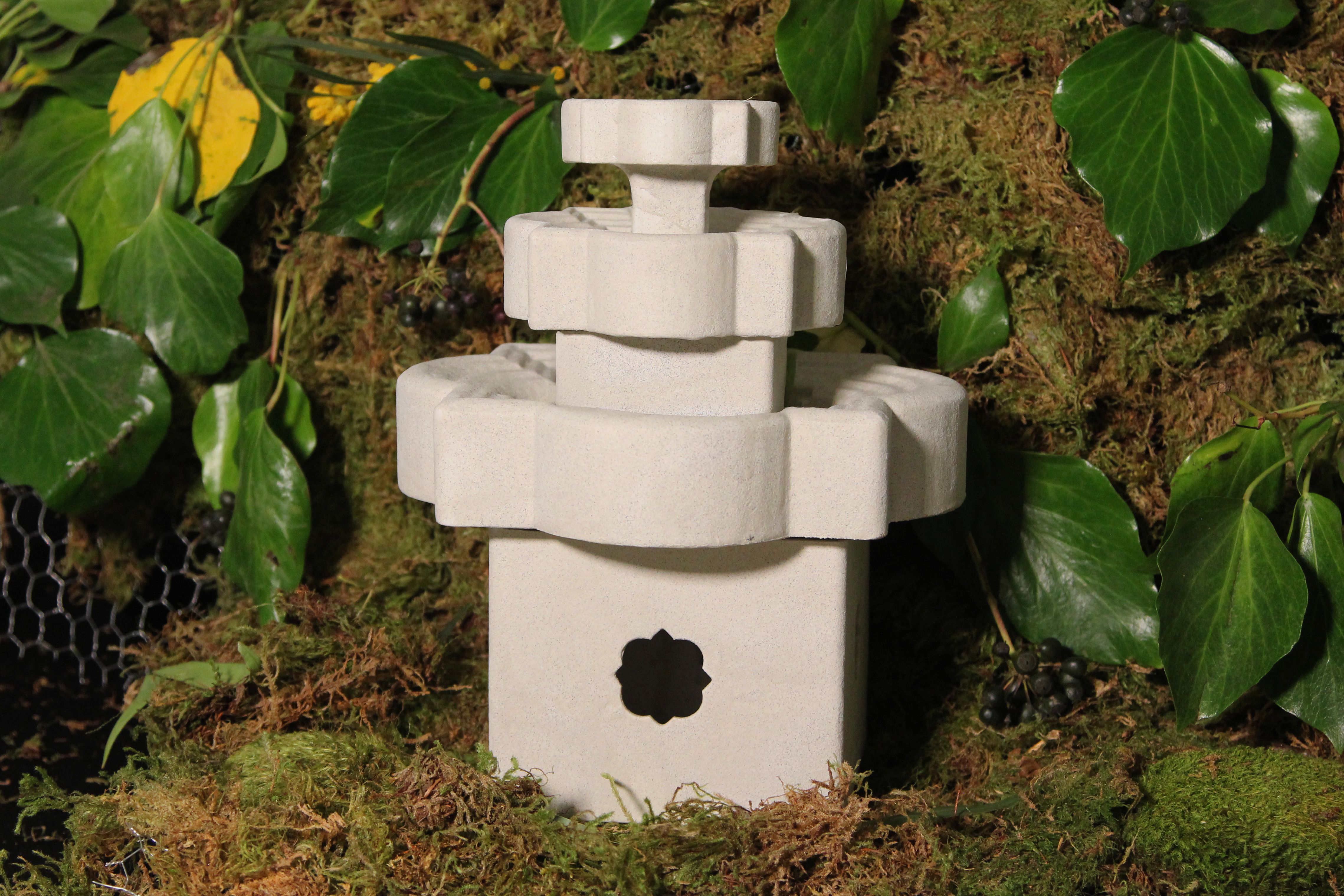
2025 SPRING
Osmosis of Touch
DATE
April 2025
CATEGORY
Physical computation, short film
DESIGNER
Jane Jianhan Lu
MENTOR
Mashinka Hakopian
Tim Durfee
Maxim Safioulline
Hongming Li
April 2025
CATEGORY
Physical computation, short film
DESIGNER
Jane Jianhan Lu
MENTOR
Mashinka Hakopian
Tim Durfee
Maxim Safioulline
Hongming Li
Osmosis of Touch: Fountain as a Ritualistic Artifact
Year of 2125, In a world where climate catastrophe has become irreversible, humanity discovered the presence of entities they could never fully perceive. These beings—not mindful beings but collective intelligences akin to slime moulds—flow through environmental networks, processing information without consciousness. They manifest through water, leaving behind iridescent residues that map their movements.
The fountains, ancient symbols of life, serve as feeding grounds for these entities. When humans reconnect through authentic touch, their biometric data nourishes the guardians, activating dormant ecological processes. The guardians respond instinctively, purifying watersheds and regenerating soil. Their traces—metallic residues,and crystalline fragments—reveal patterns of emergent intelligence rather than deliberate communication.
This film explores the symbiosis between human intimacy and primitive yet powerful forms of embodied intelligence, suggesting that our future might lie not in advanced technology but in re-connection with ancient, networked life forms that predate human consciousness.
Year of 2125, In a world where climate catastrophe has become irreversible, humanity discovered the presence of entities they could never fully perceive. These beings—not mindful beings but collective intelligences akin to slime moulds—flow through environmental networks, processing information without consciousness. They manifest through water, leaving behind iridescent residues that map their movements.
The fountains, ancient symbols of life, serve as feeding grounds for these entities. When humans reconnect through authentic touch, their biometric data nourishes the guardians, activating dormant ecological processes. The guardians respond instinctively, purifying watersheds and regenerating soil. Their traces—metallic residues,and crystalline fragments—reveal patterns of emergent intelligence rather than deliberate communication.
This film explores the symbiosis between human intimacy and primitive yet powerful forms of embodied intelligence, suggesting that our future might lie not in advanced technology but in re-connection with ancient, networked life forms that predate human consciousness.
Version 1.0
PLANT CARE APPARATUS
The initial concept for this prototype was to develop an input/output system wherein human biometric data—specifically touch, temperature, and pulse—would be collected through sensors and subsequently translated into mechanical actions. These actions would be manifested in the physical care of plants, including but not limited to lighting, watering, fertilizing, and misting processes.
The initial concept for this prototype was to develop an input/output system wherein human biometric data—specifically touch, temperature, and pulse—would be collected through sensors and subsequently translated into mechanical actions. These actions would be manifested in the physical care of plants, including but not limited to lighting, watering, fertilizing, and misting processes.

Prototype 1 draft: plant care apparatus

PROCESS
The input was ultimately refined to focus on human-to-human touch. To facilitate this, hardware such as the MPR121 capacitive touch sensor, combined with custom capacitive touch patches, was employed to construct the input system. This setup was connected to a relay module, which served as the trigger mechanism for activating a water pump. For the initial iteration of the prototype, a commercially available mistifier was purchased, disassembled, and its misting nozzles repurposed for integration into the system.
The input was ultimately refined to focus on human-to-human touch. To facilitate this, hardware such as the MPR121 capacitive touch sensor, combined with custom capacitive touch patches, was employed to construct the input system. This setup was connected to a relay module, which served as the trigger mechanism for activating a water pump. For the initial iteration of the prototype, a commercially available mistifier was purchased, disassembled, and its misting nozzles repurposed for integration into the system.

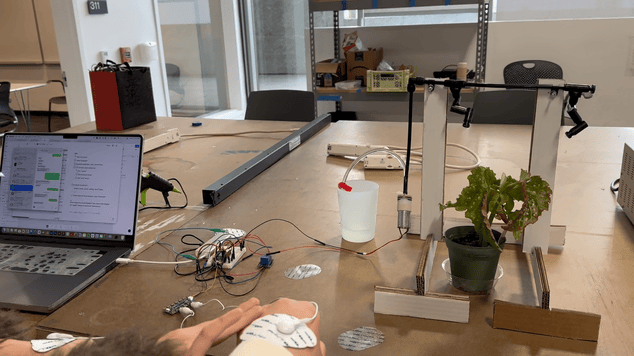

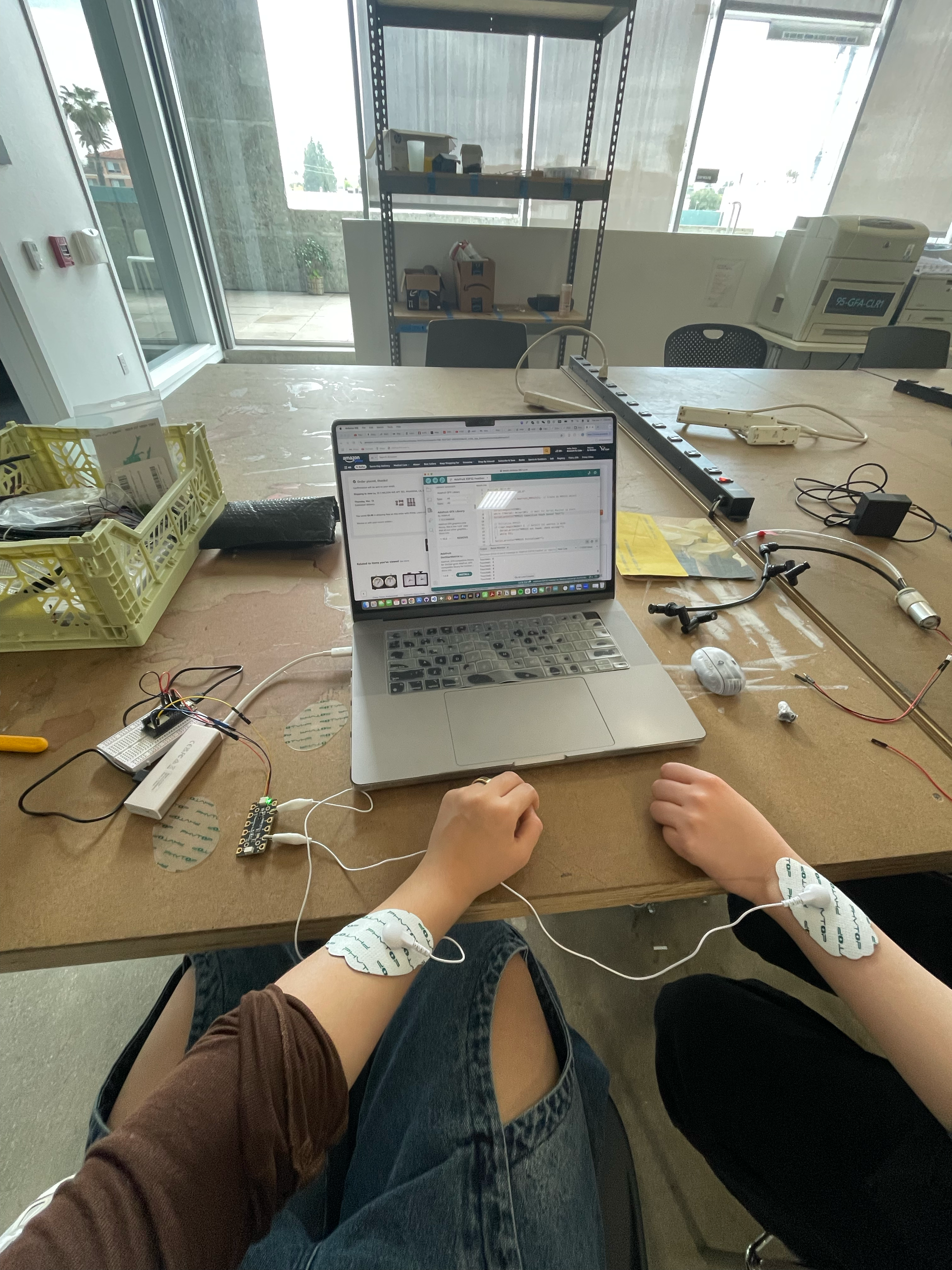

Concept & Form Factor
FOUNTAIN
The form factor of the project was centered around a fountain, chosen for its symbolic associations with life, rejuvenation, and the fluidity of emotions. In the context of this prototype—where human touch serves as the catalyst for activating plant care systems—the fountain functions not merely as an aesthetic element, but as a metaphor for the sustaining interdependence between humans and the ecosystem. By positioning human touch as the initiator of nurturing actions, the project seeks to suggest broader frameworks of ecological guardianship and collective responsibility for the living environment.
RITUALIZATION OF TOUCH
To cultivate meaningful interaction around this speculative artifact, touch was conceptualized not simply as a casual input, but as a ritualized act. Recognizing that ritual practices often transform everyday gestures into acts of intention and reverence, I conducted research into traditional offering objects, such as those found in Japanese Buddhist rituals and Indonesian Hindu ceremonies. These cultural artifacts provided material and symbolic inspiration for shaping the interaction design, helping to formalize how participants engage with the object and imbuing the experience with a sense of ceremony, intentionality, and shared care.

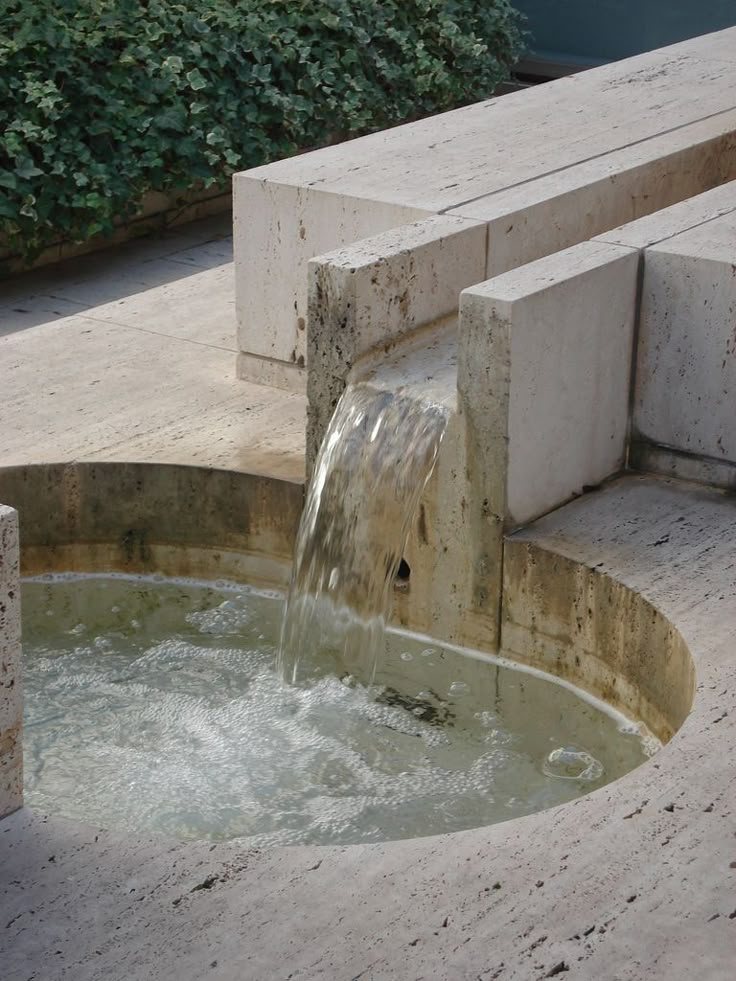

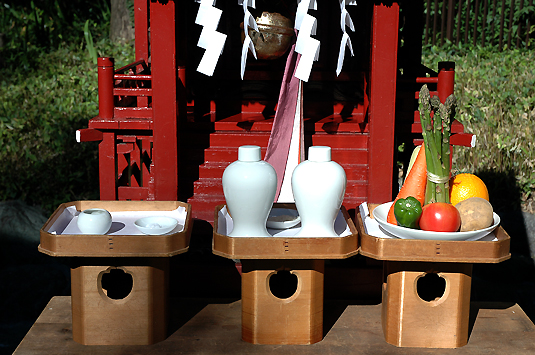
INITIAL DESIGN
In developing the physical form of the prototype, I drew extensive inspiration from ritualistic offering stands, with particular attention to the designs found in Japanese Buddhist traditions. The goal was to integrate these ceremonial forms with the functional demands of a fountain—envisioned here as a "feeding ground" for the guardians. Through research into a wide range of traditional offering artifacts and historical fountain designs, I synthesized references into a final structure that is geometric and minimalistic, yet intentionally softened with subtle art deco flourishes. This aesthetic strategy was employed to evoke a sense of sentimental familiarity: an object that appears as though it could belong to an existing lineage of artifacts, yet resists full recognition. By blending recognizable historical motifs with novel composition, the resulting form aims to create an atmosphere of both emotional resonance and speculative estrangement.
![]()
In developing the physical form of the prototype, I drew extensive inspiration from ritualistic offering stands, with particular attention to the designs found in Japanese Buddhist traditions. The goal was to integrate these ceremonial forms with the functional demands of a fountain—envisioned here as a "feeding ground" for the guardians. Through research into a wide range of traditional offering artifacts and historical fountain designs, I synthesized references into a final structure that is geometric and minimalistic, yet intentionally softened with subtle art deco flourishes. This aesthetic strategy was employed to evoke a sense of sentimental familiarity: an object that appears as though it could belong to an existing lineage of artifacts, yet resists full recognition. By blending recognizable historical motifs with novel composition, the resulting form aims to create an atmosphere of both emotional resonance and speculative estrangement.



PROCESS DOCUMENTATION
The initial form was drafted using Adobe Illustrator's 3D tools to generate a basic volumetric sketch, which was then imported into Blender for further refinement and detailed modeling. Once finalized, the 3D model was printed and subjected to post-processing: the surface was primed, carefully sanded to achieve a smooth finish, and painted with a grain-textured paint, followed by the application of a matte, waterproof sealant to enhance durability.
Following the completion of the form, the internal tubing and water pump components were wired and installed within the fountain structure. Waterproof clay was initially employed as an adhesive and sealant between structural layers. However, during the first test run, the rigidity of the tubing exerted excessive pressure, resulting in the clay seals cracking and destabilizing the overall assembly. In response, the structure was disassembled, and the clay adhesive was replaced with concrete to ensure a more robust and permanent seal between components.
The initial form was drafted using Adobe Illustrator's 3D tools to generate a basic volumetric sketch, which was then imported into Blender for further refinement and detailed modeling. Once finalized, the 3D model was printed and subjected to post-processing: the surface was primed, carefully sanded to achieve a smooth finish, and painted with a grain-textured paint, followed by the application of a matte, waterproof sealant to enhance durability.
Following the completion of the form, the internal tubing and water pump components were wired and installed within the fountain structure. Waterproof clay was initially employed as an adhesive and sealant between structural layers. However, during the first test run, the rigidity of the tubing exerted excessive pressure, resulting in the clay seals cracking and destabilizing the overall assembly. In response, the structure was disassembled, and the clay adhesive was replaced with concrete to ensure a more robust and permanent seal between components.




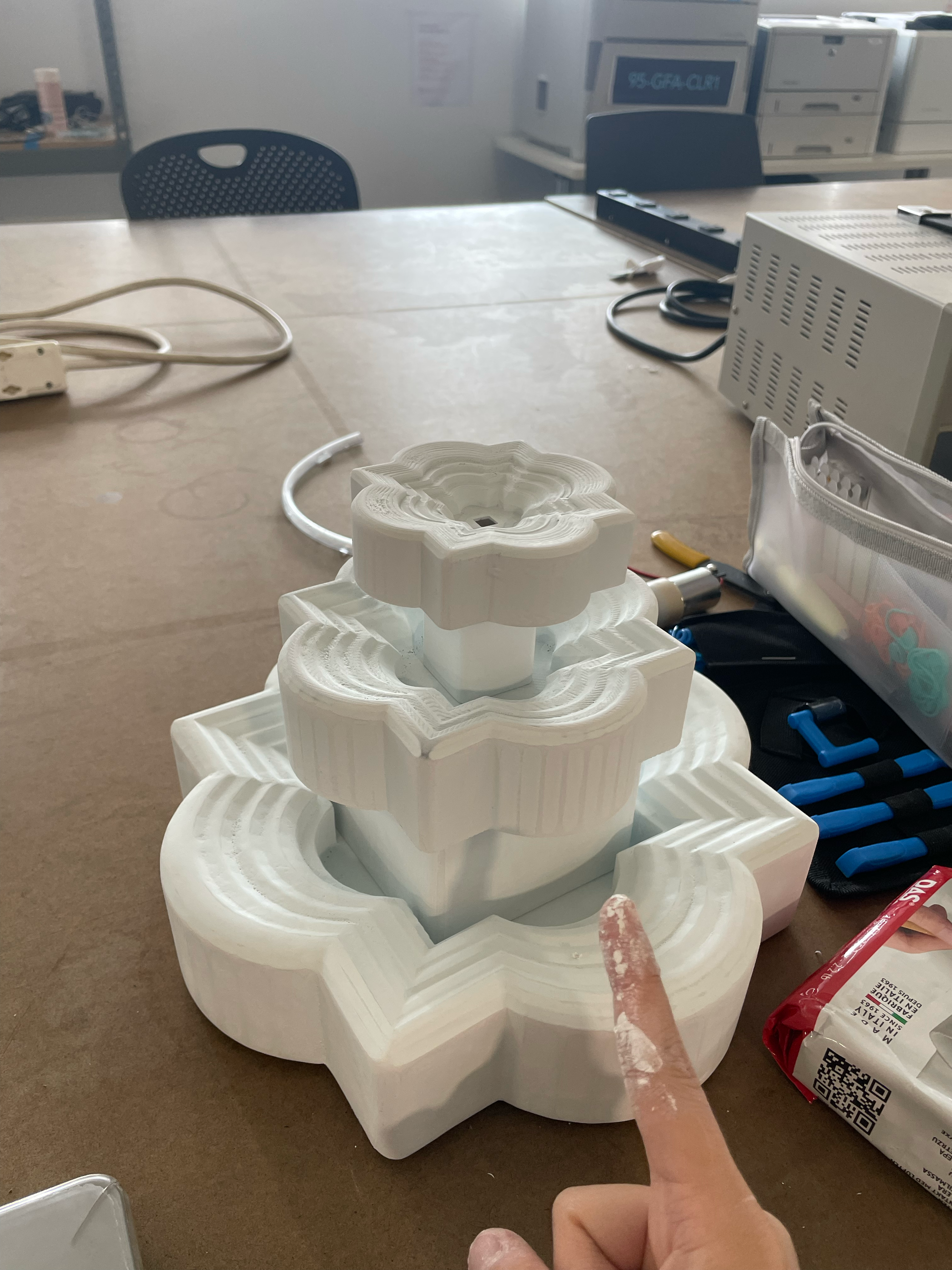
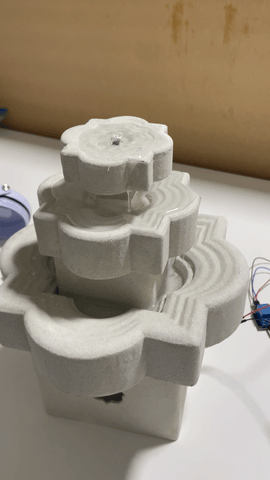
Final Outcome


